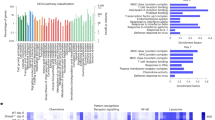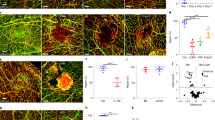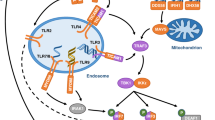Abstract
Although susceptibility of neurons in the brain to microbial infection is a major determinant of clinical outcome, little is known about the molecular factors governing this vulnerability. Here we show that two types of neurons from distinct brain regions showed differential permissivity to replication of several positive-stranded RNA viruses. Granule cell neurons of the cerebellum and cortical neurons from the cerebral cortex have unique innate immune programs that confer differential susceptibility to viral infection ex vivo and in vivo. By transducing cortical neurons with genes that were expressed more highly in granule cell neurons, we identified three interferon-stimulated genes (ISGs; Ifi27, Irg1 and Rsad2 (also known as Viperin)) that mediated the antiviral effects against different neurotropic viruses. Moreover, we found that the epigenetic state and microRNA (miRNA)-mediated regulation of ISGs correlates with enhanced antiviral response in granule cell neurons. Thus, neurons from evolutionarily distinct brain regions have unique innate immune signatures, which probably contribute to their relative permissiveness to infection.
This is a preview of subscription content, access via your institution
Access options
Subscribe to this journal
Receive 12 print issues and online access
$259.00 per year
only $21.58 per issue
Buy this article
- Purchase on SpringerLink
- Instant access to full article PDF
Prices may be subject to local taxes which are calculated during checkout






Similar content being viewed by others
Accession codes
References
Ireland, D.D.C., Stohlman, S.A., Hinton, D.R., Atkinson, R. & Bergmann, C.C. Type I interferons are essential in controlling neurotropic coronavirus infection irrespective of functional CD8 T cells. J. Virol. 82, 300–310 (2008).
Schoneboom, B.A., Lee, J.S. & Grieder, F.B. Early expression of IFN-α/β and iNOS in the brains of Venezuelan equine encephalitis virus–infected mice. J. Interferon Cytokine Res. 20, 205–215 (2000).
McGavern, D.B. & Kang, S.S. Illuminating viral infections in the nervous system. Nat. Rev. Immunol. 11, 318–329 (2011).
Delhaye, S. et al. Neurons produce type I interferon during viral encephalitis. Proc. Natl. Acad. Sci. USA 103, 7835–7840 (2006).
Wang, J. & Campbell, I.L. Innate STAT1-dependent genomic response of neurons to the antiviral cytokine α interferon. J. Virol. 79, 8295–8302 (2005).
Griffin, D.E. Immune responses to RNA-virus infections of the CNS. Nat. Rev. Immunol. 3, 493–502 (2003).
Chakraborty, S., Nazmi, A., Dutta, K. & Basu, A. Neurons under viral attack: victims or warriors? Neurochem. Int. 56, 727–735 (2010).
Omalu, B.I., Shakir, A.A., Wang, G., Lipkin, W.I. & Wiley, C.A. Fatal fulminant pan-meningo-polioencephalitis due to West Nile virus. Brain Pathol. 13, 465–472 (2003).
Gordon, B., Selnes, O.A., Hart, J. Jr., Hanley, D.F. & Whitley, R.J. Long-term cognitive sequelae of acyclovir-treated herpes simplex encephalitis. Arch. Neurol. 47, 646–647 (1990).
Samuel, M.A. & Diamond, M.S. α/β interferon protects against lethal West Nile virus infection by restricting cellular tropism and enhancing neuronal survival. J. Virol. 79, 13350–13361 (2005).
Lazear, H.M., Pinto, A.K., Vogt, M.R., Gale, M. Jr. & Diamond, M.S. β interferon controls West Nile virus infection and pathogenesis in mice. J. Virol. 85, 7186–7194 (2011).
Armah, H.B. et al. Systemic distribution of West Nile virus infection: postmortem immunohistochemical study of six cases. Brain Pathol. 17, 354–362 (2007).
Keller, B.C. et al. Resistance to α/β interferon is a determinant of West Nile virus replication fitness and virulence. J. Virol. 80, 9424–9434 (2006).
Perwitasari, O., Cho, H., Diamond, M.S. & Gale, M. Jr Inhibitor of κB kinase ɛ (IKKɛ), STAT1, and IFIT2 proteins define novel innate immune effector pathway against West Nile virus infection. J. Biol. Chem. 286, 44412–44423 (2011).
Schoggins, J.W. et al. A diverse range of gene products are effectors of the type I interferon antiviral response. Nature 472, 481–485 (2011).
Brien, J.D. et al. Interferon regulatory factor-1 (IRF-1) shapes both innate and CD8+ T cell immune responses against West Nile virus infection. PLoS Pathog. 7, e1002230 (2011).
Fang, T.C. et al. Histone H3 lysine 9 di-methylation as an epigenetic signature of the interferon response. J. Exp. Med. 209, 661–669 (2012).
Agalioti, T. et al. Ordered recruitment of chromatin modifying and general transcription factors to the IFN-β promoter. Cell 103, 667–678 (2000).
Parekh, B.S. & Maniatis, T. Virus infection leads to localized hyperacetylation of histones H3 and H4 at the IFN-β promoter. Mol. Cell 3, 125–129 (1999).
Shestakova, E., Bandu, M.T., Doly, J. & Bonnefoy, E. Inhibition of histone deacetylation induces constitutive derepression of the β interferon promoter and confers antiviral activity. J. Virol. 75, 3444–3452 (2001).
Horvai, A.E. et al. Nuclear integration of JAK/STAT and Ras/AP-1 signaling by CBP and p300. Proc. Natl. Acad. Sci. USA 94, 1074–1079 (1997).
Bhattacharya, S. et al. Cooperation of Stat2 and p300/CBP in signalling induced by interferon-α. Nature 383, 344–347 (1996).
Look, D.C. et al. Direct suppression of Stat1 function during adenoviral infection. Immunity 9, 871–880 (1998).
Vo, N. et al. A cAMP-response element binding protein-induced microRNA regulates neuronal morphogenesis. Proc. Natl. Acad. Sci. USA 102, 16426–16431 (2005).
Wayman, G.A. et al. An activity-regulated microRNA controls dendritic plasticity by down-regulating p250GAP. Proc. Natl. Acad. Sci. USA 105, 9093–9098 (2008).
Lagos, D. et al. miR-132 regulates antiviral innate immunity through suppression of the p300 transcriptional co-activator. Nat. Cell Biol. 12, 513–519 (2010).
Olsen, L., Klausen, M., Helboe, L., Nielsen, F.C. & Werge, T. MicroRNAs show mutually exclusive expression patterns in the brain of adult male rats. PLoS ONE 4, e7225 (2009).
Kim, J. et al. A microRNA feedback circuit in midbrain dopamine neurons. Science 317, 1220–1224 (2007).
Contestabile, A. Cerebellar granule cells as a model to study mechanisms of neuronal apoptosis or survival in vivo and in vitro. Cerebellum 1, 41–55 (2002).
Fine, E.J., Ionita, C.C. & Lohr, L. The history of the development of the cerebellar examination. Semin. Neurol. 22, 375–384 (2002).
Fitting, S. et al. Regional heterogeneity and diversity in cytokine and chemokine production by astroglia: differential responses to HIV-1 Tat, gp120, and morphine revealed by multiplex analysis. J. Proteome Res. 9, 1795–1804 (2010).
Labrada, L., Liang, X.H., Zheng, W., Johnston, C. & Levine, B. Age-dependent resistance to lethal alphavirus encephalitis in mice: analysis of gene expression in the central nervous system and identification of a novel interferon-inducible protective gene, mouse ISG12. J. Virol. 76, 11688–11703 (2002).
Itsui, Y. et al. Expressional screening of interferon-stimulated genes for antiviral activity against hepatitis C virus replication. J. Viral Hepat. 13, 690–700 (2006).
Degrandi, D., Hoffmann, R., Beuter-Gunia, C. & Pfeffer, K. The proinflammatory cytokine-induced IRG1 protein associates with mitochondria. J. Interferon Cytokine Res. 29, 55–67 (2009).
Tal, M.C. & Iwasaki, A. Mitoxosome: a mitochondrial platform for cross-talk between cellular stress and antiviral signaling. Immunol. Rev. 243, 215–234 (2011).
Szretter, K.J. et al. The interferon-inducible gene viperin restricts West Nile virus pathogenesis. J. Virol. 85, 11557–11566 (2011).
Fitzgerald, K.A. The interferon inducible gene: Viperin. J. Interferon Cytokine Res. 31, 131–135 (2011).
Fentress, S.J. et al. Phosphorylation of immunity-related GTPases by a Toxoplasma gondii–secreted kinase promotes macrophage survival and virulence. Cell Host Microbe 8, 484–495 (2010).
Steinfeldt, T. et al. Phosphorylation of mouse immunity-related GTPase (IRG) resistance proteins is an evasion strategy for virulent Toxoplasma gondii. PLoS Biol. 8, e1000576 (2010).
Dellacasa-Lindberg, I., Hitziger, N. & Barragan, A. Localized recrudescence of Toxoplasma infections in the central nervous system of immunocompromised mice assessed by in vivo bioluminescence imaging. Microbes Infect. 9, 1291–1298 (2007).
Strittmatter, C., Lang, W., Wiestler, O.D. & Kleihues, P. The changing pattern of human immunodeficiency virus–associated cerebral toxoplasmosis: a study of 46 postmortem cases. Acta Neuropathol. 83, 475–481 (1992).
Zhao, Y. et al. Virulent Toxoplasma gondii evade immunity-related GTPase-mediated parasite vacuole disruption within primed macrophages. J. Immunol. 182, 3775–3781 (2009).
Cheon, H. & Stark, G.R. Unphosphorylated STAT1 prolongs the expression of interferon-induced immune regulatory genes. Proc. Natl. Acad. Sci. USA 106, 9373–9378 (2009).
Hu, X., Chakravarty, S.D. & Ivashkiv, L.B. Regulation of interferon and Toll-like receptor signaling during macrophage activation by opposing feedforward and feedback inhibition mechanisms. Immunol. Rev. 226, 41–56 (2008).
Amit, I. et al. Unbiased reconstruction of a mammalian transcriptional network mediating pathogen responses. Science 326, 257–263 (2009).
Nusinzon, I. & Horvath, C.M. Positive and negative regulation of the innate antiviral response and β interferon gene expression by deacetylation. Mol. Cell Biol. 26, 3106–3113 (2006).
Zupkovitz, G. et al. Negative and positive regulation of gene expression by mouse histone deacetylase 1. Mol. Cell Biol. 26, 7913–7928 (2006).
Klein, R.S. et al. Neuronal CXCL10 directs CD8+ T-cell recruitment and control of West Nile virus encephalitis. J. Virol. 79, 11457–11466 (2005).
Coley, S.E. et al. Recombinant mouse hepatitis virus strain A59 from cloned, full-length cDNA replicates to high titers in vitro and is fully pathogenic in vivo. J. Virol. 79, 3097–3106 (2005).
Araki, T., Sasaki, Y. & Milbrandt, J. Increased nuclear NAD biosynthesis and SIRT1 activation prevent axonal degeneration. Science 305, 1010–1013 (2004).
Oliphant, T. et al. Development of a humanized monoclonal antibody with therapeutic potential against West Nile virus. Nat. Med. 11, 522–530 (2005).
Shrestha, B., Gottlieb, D. & Diamond, M.S. Infection and injury of neurons by West Nile encephalitis virus. J. Virol. 77, 13203–13213 (2003).
Acknowledgements
We thank O. Koues and E. Oltz for the experimental discussions and suggestions, J. Patel and R. Klein for their contribution to the initial phase of the study, B. Bradel-Tretheway for help with initial study design and microarray analysis, Y. Sasaki (Washington University) for the lentiviral plasmids, A. Barrett (University of Texas Medical Branch) for the SLEV, I. Frolov (University of Alabama, Birmingham) for the VEEV, H.W. Virgin (Washington University) for the Stat1−/− mice and B.K. Kleinschmidt-DeMasters (University of Colorado) and C.A. Wiley (University of Pittsburgh) for the human brain autopsy samples. US National Institutes of Health grants U54 AI081680 (Pacific Northwest Regional Center of Excellence for Biodefense and Emerging Infectious Diseases Research), U19 AI083019 (M.G. and M.S.D.) and R01 AI074973 (M.G. and M.S.D.) supported this work. The funders had no role in study design, data collection and analysis, decision to publish or preparation of the manuscript.
Author information
Authors and Affiliations
Contributions
H.C. and K.J.S. performed the experiments. H.C. and S.C.P. analyzed the microarray data. H.C. and M.S.D. designed the experiments and wrote the initial draft of the manuscript. M.G.K. and M.G. contributed to the study design and preparation of the manuscript.
Corresponding author
Ethics declarations
Competing interests
The authors declare no competing financial interests.
Supplementary information
Supplementary Text and Figures
Supplementary Figures 1–9, Supplementary Tables 1–3 and Supplementary Methods (PDF 2064 kb)
Rights and permissions
About this article
Cite this article
Cho, H., Proll, S., Szretter, K. et al. Differential innate immune response programs in neuronal subtypes determine susceptibility to infection in the brain by positive-stranded RNA viruses. Nat Med 19, 458–464 (2013). https://doi.org/10.1038/nm.3108
Received:
Accepted:
Published:
Issue date:
DOI: https://doi.org/10.1038/nm.3108
This article is cited by
-
Type I IFN signaling limits hemorrhage-like disease after infection with Japanese encephalitis virus through modulating a prerequisite infection of CD11b+Ly-6C+ monocytes
Journal of Neuroinflammation (2021)
-
Pathological modeling of TBEV infection reveals differential innate immune responses in human neurons and astrocytes that correlate with their susceptibility to infection
Journal of Neuroinflammation (2020)
-
Innate immune response in neuronopathic forms of Gaucher disease confers resistance against viral-induced encephalitis
Acta Neuropathologica Communications (2020)
-
ACOD1 in immunometabolism and disease
Cellular & Molecular Immunology (2020)
-
A balanced game: chicken macrophage response to ALV-J infection
Veterinary Research (2019)



